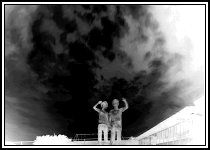
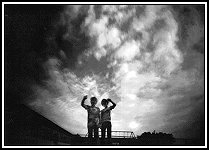


On the left is the "paper negative", which is the film from the pinhole camera after it has been developed. On the right is a "print", or positive, made from the paper negative. The exposure time for this picture was about 15 seconds. Because the camera was aimed toward the bright sky, it took less than the "normal" 20 seconds to expose the paper film.
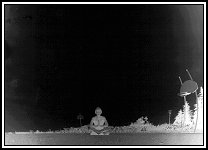
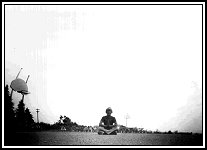
The Buddha by the Backboard
Again the negative is on the left, the print, or positive, on the right. When light strikes a particle of silver nitrate in the photographic paper, something happens to it which causes it to turn into a tiny speck of silver when the paper film is developed. That is why the sky is black in the negative: lots of light passed through the pinhole and struck the paper film in the sky part of the image. When developed, billions of tiny particles of silver were formed which make the sky look black.
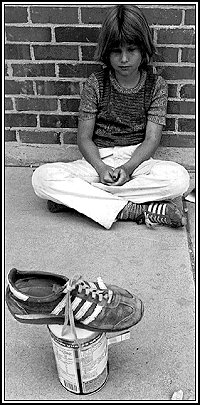 When
making an exposure ("taking a picture"), it is important to decide what you want
the picture to include. Remember, the background will probably take up most of your
photograph, so consider the background as well as the "subject" of the picture,
which usually is in the foreground. In other words, the subject usually is closest to the
camera. Also, because the exposure time averages about 20 seconds on a bright day, the
camera cannot move while it is "taking" a picture. This means that the camera
must be set on something, usually the ground. You cannot hold the camera still for 20
seconds--if you try you will get a fuzzy picture or no picture at all! The girl above has
placed her shoe on top of her camera to help keep the camera steady for the 20 second
exposure time. She is making an exposure of herself, and she knows that she cannot move
for 20 seconds. She opened the shutter and then "froze", silently counting off
"one-thousand-one, one-thousand-two, ..." up to a count of twenty seconds. Only
then did she move--to close the shutter.
When
making an exposure ("taking a picture"), it is important to decide what you want
the picture to include. Remember, the background will probably take up most of your
photograph, so consider the background as well as the "subject" of the picture,
which usually is in the foreground. In other words, the subject usually is closest to the
camera. Also, because the exposure time averages about 20 seconds on a bright day, the
camera cannot move while it is "taking" a picture. This means that the camera
must be set on something, usually the ground. You cannot hold the camera still for 20
seconds--if you try you will get a fuzzy picture or no picture at all! The girl above has
placed her shoe on top of her camera to help keep the camera steady for the 20 second
exposure time. She is making an exposure of herself, and she knows that she cannot move
for 20 seconds. She opened the shutter and then "froze", silently counting off
"one-thousand-one, one-thousand-two, ..." up to a count of twenty seconds. Only
then did she move--to close the shutter.
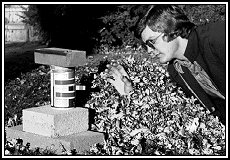
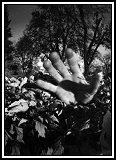
Here is one last example of how to place the camera. With a the weight of a brick holding it down, only the background can move during this exposure, certainly not the camera! The hand is slightly blurred, but so are the tree limbs in the background because of the wind. Even though the camera is only about a foot from the hand, in the print the hand takes up less than 1/4 of the total picture area. Best results are usually achieved by placing the camera close to the subject. These cameras work like a "normal" camera with a very wide-angle lens (in fact, they make photos almost as good as ones made with lenses which cost hundreds of dollars!)
Back - Home - Next